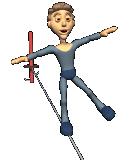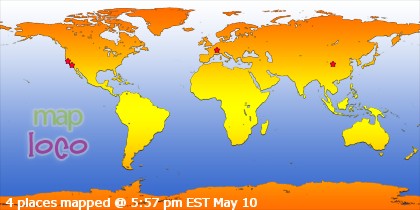Tuesday, July 05, 2011
..Making Circus: Crafting the Story..
When the 2008-2009 circus season ended, the trapeze fliers packed up their nets and gear, the clowns removed their greasy face paint for the last time, and Show of Force, the documentary team behind CIRCUS, put down the cameras and boom microphones they'd been carting around for the better part of a year. When the last spotlight went dim, the documentary team had amassed more than 2000 hours of footage, and the editors — E. Donna Shepherd and Howard Sharp — were challenged to sit down in front of all that raw cinematic material and shape a six-part documentary.
Luckily Shepherd and Sharp are seasoned editors who learned much about large-scale documentary production and each other's editing styles while working together on PBS' CARRIER, a ten-hour documentary profiling life on the Navy's USS Nimitz as the carrier deployed to the Persian Gulf in 2005. The documentary won the 2008 Emmy(R) Award for Outstanding Cinematography.
"You really have to work with the material you're given to find what will sustain the story arc," says Editor Howard Sharp.
Originally the two veteran editors were going to alternate editing the series: one person taking episodes one, three and five, and the other taking two, four and six. But that plan changed when Sharp fell in love with the clowns.
"I like the idea that clowning is such an art and science," says Sharp. "Barry teaching Glen and Steve teaching Glen, I thought that was interesting. On top of that, Glen and Barry turn out to be extraordinary characters."
Because the clown storyline falls predominantly in episodes two and three, the editors divvied up editing duties, and Shepherd ended up editing the first and last episodes, two of the most difficult pieces of the overall documentary puzzle.
"(Episode) six is very tough because, in a sense, it's all about the same thing. It's a sweeping up, and you have to keep it up in the air and not make it repetitive," says Sharp. "Not a lot happens in that last hour — the big dramas have already happened, but you have to keep an audience interested and you have to satisfy the need for an end."
Traditionally, Show of Force Executive Producers Maro Chermayeff and Jeff Dupre assign the editors different characters and let them study the materials to build individual stories. Because there are far too many hours of footage for anyone to watch in entirety, the two editors view only the material that pertains to their particular characters, as well as the pivotal interviews with main characters such as Big Apple Circus Founders Paul Binder and Michael Christensen and Guest Director Steve Smith.
Both editors also rely heavily on a team of "loggers," who watch all the hours of material and mine it for rich moments and well-produced scenes.
Once the editors had their individual character assignments and a command of the raw material, the next step was to cut individual story lines, a challenge for two editors who have vastly different working and editing styles.
Sharp tends to edit in a linear, traditional story line. For instance, he worked to develop the Big Apple Circus clown, Barry Lubin's profile, and as he discovered Lubin's story arc, Sharp edited an hour of the veteran clown's footage together into a cohesive story. Later, Shepherd and Sharp worked together to weave all these disparate stories through the episodes, making sure to note where various scenes resonate emotionally with the surrounding material.
Shepherd, on the other hand, forms her character's stories very differently.
"I have a Rubik's Cube process. I don't work from A to Z. Instead, I edit small moments and then find how the story makes sense," she says. For instance, Shepherd describes a scene that takes place early in the CIRCUS series between Ryan "Yuri" Clark and Heidi Wierbilis, in which the two of them are dining at a small cafe following Yuri's release from jail for allegedly calling in a bomb threat to the Big Apple Circus. There's a great deal of tension between them as Yuri contemplates leaving the country, while his wife, Heidi, is considering staying with the circus and her job as a horse groom.
"I love the moment when Yuri describes how the prison doors shut and it felt, to him, like a 'velociraptor,' and (Heidi) laughs with him because she gets him; they share that humor, and you see that (to stay or leave with him) is a hard decision for her," says Shepherd.
Once the two editors have edited individual story lines, the job of fitting these individual tales into an overall cohesive, episodic format becomes the aim. The duo completed the first two episodes and did a great deal of screening with Chermayeff and her Show of Force partner, Jeff Dupre, as well as the film producers and photographers.
"Once we cut everything, we actually felt like there wasn't enough performance in the piece," recalls Shepherd. "But the aim (of the documentary) wasn't to make a performance video. It's really about the characters, so you might see a lot of the twins juggling, but we (include the performance footage) to illustrate how they're not getting along," she says.
Another challenge for Shepherd and Sharp was to seamlessly integrate their two very different editing styles into one seamless piece of work. While Sharp is known for his beautiful, cinematic work, Shepherd's style tends towards energetic and exciting pieces.
"We have to reach to each others' style, to make it a cohesive, overarching style," explains Sharp. "But we've been working together since the beginning of CARRIER — five years — and we've learned a lot."
Both Sharp and Shepherd count themselves lucky to get to work with such character-rich, in-depth material. And both walk away from this project profoundly moved by the circus experience and the people who make magic under the big top.
"I was left with a real appreciation of the work and the hardship of the people who do this. It's really extraordinary," says Sharp.
"We're very fortunate to work on this project," says Shepherd. "Maro and Jeff really gave us the time to create ... and I thought after CARRIER I would never get to do this (type of long-form documentary work) again, and then along came CIRCUS," she says.
Subscribe to:
Post Comments (Atom)














0 comments:
Post a Comment